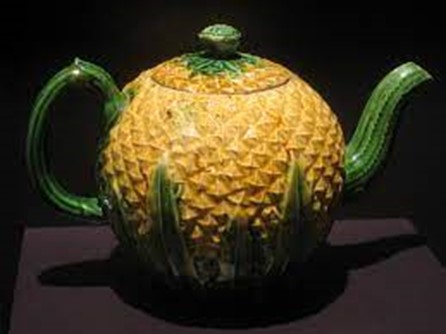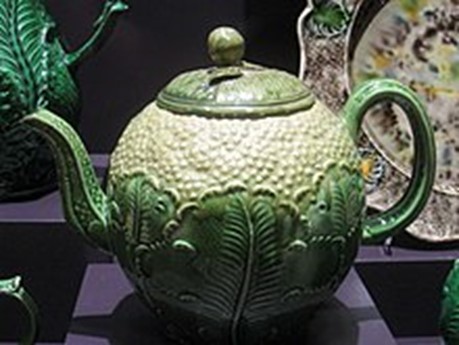In January 1773, merchant Samuel Wharton wrote the following observations about tea drinking in America.
"The use of teas, and of the black sort in particular, is so common and fashionable in America that it is usually drank twice a day, even by the Frontier inhabitants of all the colonies from New York to North Carolina inclusive; for the expense of transporting it is so very trivial, that the land carriage, quite from Philadelphia to the Ohio is only about a penny a pound. In short, the practice of tea drinking is so prevalent that the tribes of the Mohocks and Cononjohare Indians upon the Mohocks River in the Province of New York drink it frequently twice a day as do many of the Delawares upon Ohio." 1
Great Britain passed the Tea Act of 1773 giving the East India Company a monopoly on tea shipped to America. It undersold tea exporters other than the ones chosen by them. The Sons of Liberty began a movement to boycott tea and refused to unload the East Indian ships when they got to America. Ultimately, on the night of December 16, 1773, a group of men disguised as Indians boarded the tea ship Dartmouth in Boston’s Harbor and threw its chests of tea overboard. To punish Boston, Britain enacted a series of laws that came to be known as the Intolerable Acts. 2
As a result of these Intolerable Acts, not only did it become unpatriotic for Americans to drink China tea, but it became harder to come by, and more expensive. Agnes Steel, the wife of Reverend John Steel of Carlisle, wrote to Philadelphia merchant John Mitchell in July 1776. She begged his pardon for writing to him when she was a stranger to him. “I am informed,” she wrote, “that you have a quantity of tea on hand of an old importation and I hope it’s no way detrimental to our country to dispose of what is already in the country…” 3
Carlisle merchants John Holmes and Ephraim Steel wrote to Philadelphia merchant John Mitchell on February 2, 1776. “We being informed that the Congress have allowed that what Tea is on hand may be sold, if it is so we request of you to send of us 50 Wt. if it be any way in reason as to price.” 4
Tea was partaken using a variety of unmatched ware. Estate inventories and shopkeeper’s account books describe the types of items used for tea drinking. Thomas Whieldon’s potteries near Stoke-on-Trent, England were producing “Whieldon ware,” a creamware in naturalistic forms such as Pineapple ware, Cauliflower ware and Agate ware. These items were shipped to merchants in Philadelphia for sale in America. The account book of Ephraim Blaine of Carlisle for the years 1765 and 1766 reveals that on the day after Christmas, 1765 he sold three pineapple tea pots to James McCaslin, and on January 14, 1766, he sold one to Paul Pierce. Whieldon also made creamware with a green and brown glaze called “Tortoiseshell ware.” Blaine sold a tortoise shell tea pot to McCaulslin and a tortoise shell sugar dish to John Pollock of Carlisle. “Penciled” tea ware was also popular. Pencilling was a technique that involved using a very fine brush to draw a decoration in black on a piece of porcelain. During 1765 and 1766, Blaine sold penciled tea pots to Reverend John Steel’s son-in-law Robert Semple of Carlisle, to Judge Hermanus Alrick’s wife, to tailor James McClintock and to John Pollock. 5
Carlisle inventories often mentioned teacups of blue and white “China,” white “China,” stone, or Queensware. Creamers were called cream jugs or cream pots, and the receptacle for sugar was called a sugar dish. Granulated sugar was not available in the eighteenth century but came in a loaf and had to be cut with nippers which could be placed on the sugar dish.
Inventories reveal some of the items that were associated with tea drinking including tea tables. Designed especially for that purpose, although tea tables could be rectangular, the tripod table with a circular top was the most popular form in the second half of the eighteenth century. Tea tables were made in walnut and cherry, but the most desirable and the most expensive tables were made of mahogany and were usually kept in the “best parlor,” or “front parlor.”
The 1761 inventory of Carlisle tavernkeeper and joiner Andrew McIntyre listed a tea table “in the parlour,” three tea pots, six cups and saucers, eleven silver tea spoons and a silver cream pot. 6 If a man were prosperous, he often owned silver tea spoons, usually six in number. If he were very prosperous, he might also own a pair of silver tongs and a silver cream jug. The 1771 inventory of Carlisle cabinetmaker William McCoskry listed a tea table, a pewter tea pot, one set of “China” tea ware with two pots, six silver tea spoons and a pair of silver tongs. Indian trader Joseph Spear’s 1782 inventory listed two tea tables (one mahogany and one walnut), two China tea pots and a striped one, a silver tea pot, a pencilled sugar dish, a “China” cream jug and a dozen silver tea spoons. Cumberland County Judge Hermanus Alricks’ inventory was taken in 1773. His wealth was displayed in his household goods. Tea related items included a tea table, one half dozen China tea cups, one China tea pot, one China sugar dish, six tea cups and four saucers “Queens ware,” one tea pot, one cream jug, and two English brown porcelain tea pots. His silver equipage included one tea pot, eleven tablespoons, seven tea spoons and tea tongs, and one cream jug. 7
The original estate inventories are housed at the Cumberland County Archives in Carlisle, and microfilmed copies are available at the Cumberland County Historical Society. The society also has a collection of original 18th and 19th century merchants and shopkeepers account books/day books as well as several on microfilm.

